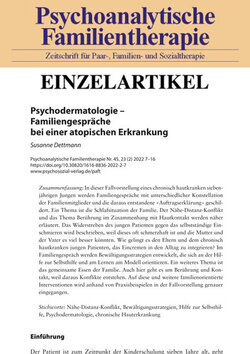10 Seiten, PDF-E-Book
Erschienen: Dezember 2022
Bestell-Nr.: 29242
https://doi.org/10.30820/1616-8836-2022-2-7
abonnieren
Susanne Dettmann
Psychodermatologie - Familiengespräche bei einer atopischen Erkrankung (PDF)
Sofortdownload
Dies ist ein E-Book. Unsere E-Books sind mit einem personalisierten Wasserzeichen versehen,
jedoch frei von weiteren technischen Schutzmaßnahmen (»DRM«).
Erfahren Sie hier mehr zu den Datei-Formaten.
In dieser Fallvorstellung eines chronisch hautkranken siebenjährigen Jungen werden Familiengespräche mit unterschiedlicher Konstellation der Familienmitglieder und die daraus entstandene »Auftragserklärung« geschildert. Ein Thema ist die Schlafsituation der Familie. Der Nähe-Distanz-Konflikt und das Thema Berührung im Zusammenhang mit Hautkontakt werden näher erläutert. Das Widerstreben des jungen Patienten gegen das selbstständige Einschmieren wird beschrieben, weil dieses oft schmerzhaft ist und die Mutter und der Vater es viel besser könnten. Wie gelingt es den Eltern und dem chronisch hautkranken jungen Patienten, das Eincremen in den Alltag zu integrieren? Im Familiengespräch werden Bewältigungsstrategien entwickelt, die sich an der Hilfe zur Selbsthilfe und am Lernen am Modell orientieren. Ein weiteres Thema ist das gemeinsame Essen der Familie. Auch hier geht es um Berührung und Kontakt, weil daraus Konflikte entstehen. Auf diese und weitere familienorientierte Interventionen wird anhand von Praxisbeispielen in der Fallvorstellung genauer eingegangen.
Abstract:
This case presentation is about a seven years old child with a chronic skin disease. It describes family talks with different family members. One topic is the sleeping situation of the family where the closeness-distance-conflict and touch in connection with skin contact are explained in more detail with the help of the literature. The young patient’s resistance to self-smearing is described because this is often painful and his mom and dad can do it much better. How do the parents and the young patient with chronic skin disease manage to integrate creaming into everyday life? Coping strategies are developed in family talks which are based on help to self-help and learning from a role model. Another topic are the family meals. It is about touch and contact because it creates conflicts. This and other family-oriented interventions are discussed in more detail using practical examples in the case presentation.
Abstract:
This case presentation is about a seven years old child with a chronic skin disease. It describes family talks with different family members. One topic is the sleeping situation of the family where the closeness-distance-conflict and touch in connection with skin contact are explained in more detail with the help of the literature. The young patient’s resistance to self-smearing is described because this is often painful and his mom and dad can do it much better. How do the parents and the young patient with chronic skin disease manage to integrate creaming into everyday life? Coping strategies are developed in family talks which are based on help to self-help and learning from a role model. Another topic are the family meals. It is about touch and contact because it creates conflicts. This and other family-oriented interventions are discussed in more detail using practical examples in the case presentation.
Michael StaschS. 5–6Editorial (PDF)
Susanne DettmannS. 7–16Psychodermatologie - Familiengespräche bei einer atopischen Erkrankung (PDF)
Günter ReichS. 17–23Familienpsychosomatik - Einführung in Konzepte, Forschung und Therapie (PDF)
Anke DalhoffS. 25–51KörperEmpfinden (PDF)
Psychoanalytische Familientherapie und Konzentrative Bewegungstherapie in der Behandlung jugendlicher Anorexia nervosaCorina Rink & Ines Weirauch S. 53–68Sozialtherapie meets Corona-Pandemie - bleibt alles anders? (PDF)
Gedanken und Fragmente zum ThemaJoanna Wegerer & Joseph Kleinschnittger S. 69–92Die Bedeutung des beziehungsdynamischen Arbeitsansatzes für das Arbeitsfeld der Schulpsychologie im Kontext von Migration und Flucht (PDF)
Michael Stasch, Harald Forkel, Yeşim Reichert, Niels Schwindt, Johannes C. Ehrenthal & Stephan Gingelmaier S. 93–105Eine Operationalisierte Psychodynamische Diagnostik (OPD) für Beziehungssysteme (PDF)
Elke Rosenstock-Heinz & Christian Braeunlich S. 107–117Familientherapeutisches Setting in unterschiedlichen Institutionen (PDF)
Elisabeth von Salis & Thomas von Salis S. 119–138Amor und Psyche (PDF)
Das göttliche Dispositiv in der Familienpsychotherapie
Susanne DettmannS. 7–16Psychodermatologie - Familiengespräche bei einer atopischen Erkrankung (PDF)
Günter ReichS. 17–23Familienpsychosomatik - Einführung in Konzepte, Forschung und Therapie (PDF)
Anke DalhoffS. 25–51KörperEmpfinden (PDF)
Psychoanalytische Familientherapie und Konzentrative Bewegungstherapie in der Behandlung jugendlicher Anorexia nervosaCorina Rink & Ines Weirauch S. 53–68Sozialtherapie meets Corona-Pandemie - bleibt alles anders? (PDF)
Gedanken und Fragmente zum ThemaJoanna Wegerer & Joseph Kleinschnittger S. 69–92Die Bedeutung des beziehungsdynamischen Arbeitsansatzes für das Arbeitsfeld der Schulpsychologie im Kontext von Migration und Flucht (PDF)
Michael Stasch, Harald Forkel, Yeşim Reichert, Niels Schwindt, Johannes C. Ehrenthal & Stephan Gingelmaier S. 93–105Eine Operationalisierte Psychodynamische Diagnostik (OPD) für Beziehungssysteme (PDF)
Elke Rosenstock-Heinz & Christian Braeunlich S. 107–117Familientherapeutisches Setting in unterschiedlichen Institutionen (PDF)
Elisabeth von Salis & Thomas von Salis S. 119–138Amor und Psyche (PDF)
Das göttliche Dispositiv in der Familienpsychotherapie

